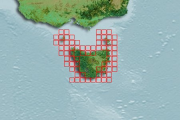Southern rock lobster
Type of resources
Topics
Keywords
Contact for the resource
Provided by
Years
-

Southern Rock Lobster (Jasus edwardsii) biological data collected by observers on commercial boats and dedicated research trips incorporating information on sex, length, weight, damage, reproduction, bycatch, protected species interaction, location, depth, tagging and equipment type.
-
Southern Rock Lobster (Jasus edwardsii) that are about to moult or have recently moulted have reduced market value due to higher mortality in live transport, higher cannibalism and lower meat recovery. Limiting the landing of softer shelled lobsters is desirable to maintain product quality. The effects of several factors on durometer readings were evaluated: sex, temperature (ambient plus elevated 3°C), location (from around the coast), and size (carapace length). Individuals were collected across two regions South Australia and Tasmania.
-
To test if the carapace length of lobsters changes during cooking, 21 legal-sized southern rock lobsters were collected in pots from Alum Cliffs, south-eastern Tasmania, Australia in October 1999 (42.95±S 147.35±E). The sample consisted of 7 female and 14 male lobsters ranging in carapace length from 106 mm to 153 mm (mean 120 mm). Each animal was abdominally tagged using individually marked t-bar tags (Hallprint T-bar anchor tag, TBA1; Hallprint Pty Ltd, 27 Jacobsen Crescent, Holden Hill, SA 5088, Australia). The carapace length of all lobsters were measured five times to the nearest 0.1 mm in a random manner, before and after processing. This repeated measurement of all specimens in random order was intended to evaluate measurement error. Processing was typical of that used commercially and involved killing the lobsters in fresh water before cooking in pre-boiling salted water for 12 minutes.
-
1. Workforce Tasmania’s commercial fishing industry workforce is defined as those people engaged in economic activity (work) within the sector across or at a given time, either in paid employment or self-employment. For fisheries this includes skippers and crew employed as sub-contractors and paid on a share of catch arrangement. It can include people engaged in unpaid work undertaken as part of these activities, although this has not been included in this assessment. Monitoring workforce changes is important because these changes indicate changes in social and economic benefits at a statewide and regional community level. Factors which affect workforce size include the extent to which a policy of maximizing technical efficiency is pursued through management, which typically reduces the fleet size and therefore the number of people employed. Other factors include the level of stock availability and access, the cost of entry into the fishery, and the financial profitability of fishing. Because of these factors, many fishers are engaged in employment in multiple fisheries or other marine sectors in order to supplement fishing incomes and pursue full-time employment. 1.1. Abalone The commercial harvesters catching abalone species operate within the Tasmanian Abalone Fishery. Assessment of workforce indicators is undertaken at fishery level. The data provided for this fishery is for the Tasmanian Abalone Fishery as a whole, which includes harvesting activity for this species as well as all other species caught in this fishery. 1.2. Commercial Dive species The commercial harvesters catching these species operate within the Tasmanian Commercial Dive Fishery. Assessment of workforce indicators is undertaken at fishery level. The data provided here is for the Tasmanian Commercial Dive species as well as all other species caught in this fishery. 1.3. Giant crab species The commercial harvesters catching giant crab operate within the Tasmanian Giant Crab Fishery. Assessment of workforce indicators is undertaken at fishery level. 1.4. Scalefish species The commercial harvesters catching this scalefish species operate within the Tasmanian Scalefish Fishery. Assessment of workforce indicators is undertaken at fishery level. The data provided here is for the Tasmanian Scalefish Fishery as a whole, which includes harvesting activity for this species as well as all other species caught in this fishery. 1.5. Scallop species The commercial harvesters catching species of scallop operate within the Tasmanian Scallop Fishery. Assessment of workforce indicators is undertaken at fishery level. 1.6. Southern rock lobster The commercial harvesters catching southern rock lobster operate within the Tasmanian Rock Lobster Fishery. Assessment of workforce indicators is undertaken at fishery level. 2. Workforce Indicators 2.1. Persons Workforce size (the total number of people directly employed) includes both skippers and crew, and those employed full time and part time. 2.2. Employment FTE The number of Full Time Equivalent (FTE) positions in each fishery is also estimated. This indicator shows that while a higher number of people may be employed in a fishery, some of these jobs may be part-time. Therefore, the number of FTEs is typically lower than the number of people in the workforce. In this iteration of the dataset, this value is unavailable for the abalone fishery in 2016, 2017, and 2019, and does not apply to the scallop fishery in any of the years available (2016-2020). 2.3. Active Supers The number of supervisors (skippers) employed in the fishery. 2.4. Harvest Units (TAS HP) The number of harvest units (combination of licensed vessel and fishing entitlement) active in a fleet and the number of people who actively harvest fish as supervisors (skippers) in a commercial fishery are directly linked to the size of the workforce in each fishery. In many cases, multiple supervisors may be linked to the same harvest unit, so the number of supervisors is often higher.
-
The impacts of a small, free-field, surface explosion from a ship scuttling, on two crustacean species was examined. The southern rock lobster (Jasus edwardsii) and the spotted shore crab (Paragrapsus gaimardii) were used to compare the effects on crustaceans in a controlled experiment on animals distributed up to 500 m from the blasts. Methods for assessing damage included; mortality, behavioural experiments, and physiological assessments.
 IMAS Metadata Catalogue
IMAS Metadata Catalogue